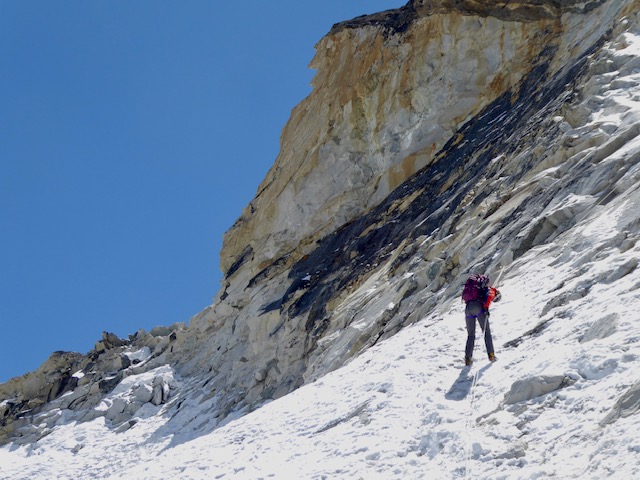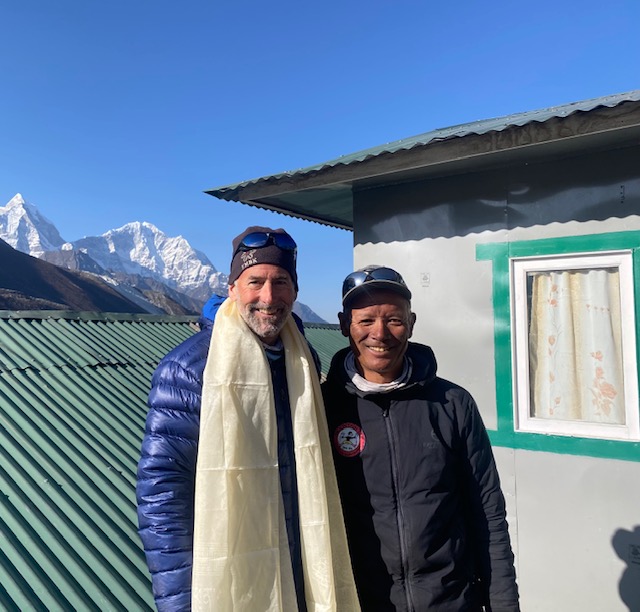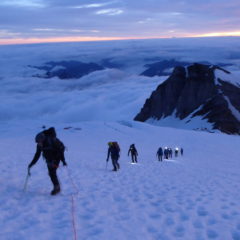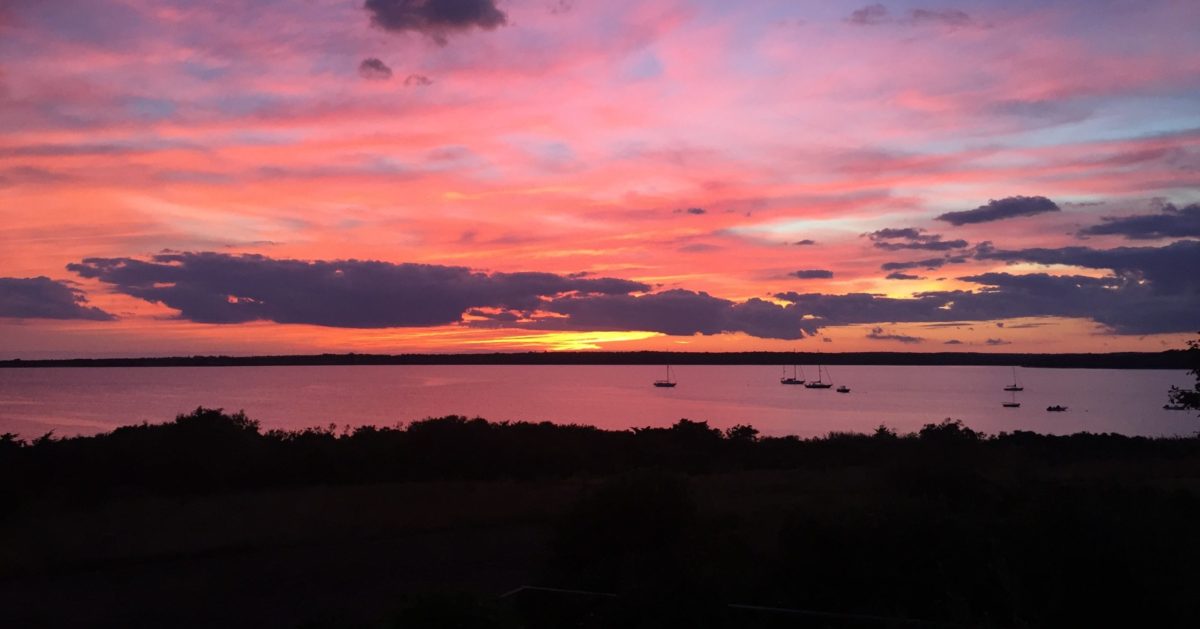As described in my last post from Kathmandu, I decided to replace the traditional approach to Everest base camp this year with a longer, more challenging trek/climb through the remote Makalu-Barun region. I sought to add a new life experience into the mix as I return for a second attempt on the mountain.
Yesterday, my friend Bob and I pulled into the Khumbu village of Dingboche after eighteen days of hard trekking and climbing. For the first half, we were joined by Bob’s wife Ann and friend Brad. We experienced stunning natural beauty, trails and villages devoid of foreigners, comradeship, physical challenge, and high pass crossings that tested our limits. If I headed home tomorrow, I would count this among the cherished experiences of my life. Mission accomplished.
THE FIRST HALF
As is often the case, getting from Kathmandu to the start of our trek was a challenge in its own right. Our plan was to fly to the village of Tumlingtar, then ride in a jeep five hours to the smaller village of Num, where the road ends. Unfortunately, cloudy weather had grounded the flights for days. We showed up at Kathmandu airport in any event, hoping for the best. After waiting in the chaotic domestic departures area for several hours, we were told that that Tumlingtar airport had just opened. The small plane boarded. We were elated.
We took off and flew along the edge of the mountains, with great views of the highest peaks rising above the clouds. As we approached Tumlingtar, the plane suddenly did a 180 degree turn. The high peaks that had been visible on the left side of the plane were now on the right side of the plane. The pilot announced that Tumlingtar airport had again closed and we were returning to Kathmandu, which we did.
The weather forecast for the following days looked no better, so we hastily diverted to Plan B: finding a helicopter that could take us directly to Num. The next day we were back at the airport. While conditions remained very cloudy, the helicopter operators thought they could follow river valleys and navigate safely. As we handed over our bags, another problem arose. Our collective luggage was 70 kilos over the takeoff limit. The operators wouldn’t budge, and we needed every item in our luggage for the trek.
After an hour of negotiation, a solution emerged. Seventy kilos of helicopter fuel were identified in Num, connected to a local dam construction project. This would be provided to the pilot in Num for his return flight to Kathmandu. Seventy kilos of fuel were then offloaded from our reserves leaving Kathmandu. After several more hours of waiting, we boarded the helicopter and took off.
Heavy clouds prevented the pilot from flying the direct route over the ridge lines. As planned, he stayed low and used river valleys to navigate. For a long while, we followed the Sun Kosi, one of Nepal’s renowned rivers which I kayaked with three great people in 1982. It was a thrill to look down and pick out specific rapids we negotiated. I thought I could also identify specific river banks where we camped, but that was probably stretching it.
Near Tumlingtar, the pilot swung hard left and began following the Arun river up into the foothills. A while later, he swung right and followed a steep ridge up into the clouds to where Num was perched. We circled and landed in a small enclosure between houses, with much of the village looking on. We had made it!
Our trek staff had been in Num for several days, waiting for us. In the more popular trekking areas, employing large retinues of support staff as was done by expeditions historically has been replaced by traveling lighter, relying on small lodges called “tea houses” for lodging and meals. Given the limited tea house infrastructure in the Makalu region, coupled with my desire to eat well and stay healthy in advance of Everest, we were in full “expedition mode”. In addition to lead guide Pasang Gombu Sherpa and assistant guide “Bali” Tamang Sherpa, our retinue included a cook, three cook staff, and thirteen porters. The number of porters would be reduced as the trek advanced.
Given the technical nature of the climbing that Bob and I would encounter in the back half of the trek, I had worked hard to secure experienced guides. Pasang Gombu and Bali had eleven Everest summits between them and were very familiar with our route. Both were on Everest last year, climbing with a group on a similar schedule to ours. They too had been forced by the bad weather to turn around. We had lots of notes to compare.
Given that it was mid afternoon when we arrived in Num, Gombu and Bali assumed that we would spend the night there and start our trek the following morning. But we were eager not to lose another day and convinced them to hit the trail right away, even if it meant arriving at our destination after dark. So that is what we did; descending 3,000 vertical feet through steeply terraced fields, crossing the Arun river on a suspension bridge. and ascending 3,000 vertical feet up the other side of the valley to the village of Seduwa. We hiked the last hour in darkness, and shortly before Seduwa it began pouring rain, but we made it. Our trek was officially underway. It felt great.
Over the next few days, we settled into our trekking rhythm, passing through small villages, laboriously cultivated fields, and rhododendron forests. It was the charm I have long savored when trekking in Nepal, enhanced by being in a region that sees few foreign visitors. It was timeless. Here is the view out of my tea house window on night two:

As we ascended, we left the year-round villages behind and temperatures dropped. On day four we crossed the 13,500 foot “Shipton Pass”, named for the British climber who passed through this area in 1952 with Edmund Hillary as part of the Everest reconnaissance expedition. The heavy rains we had experienced lower down caused the pass to be covered in snow:

By day seven we were among the high peaks:

On day eight we arrived at Makalu base camp, beneath the world’s fifth highest mountain. The next day, we started before dawn and climbed to a saddle at 17,000 feet, where we had spectacular views in all directions, including of Everest glowing in the early morning light. Here is a photo of Pasang Gombu and our group, with Makalu behind us:

The following morning, a helicopter arrived to, in the words of our logistics coordinator, “extract” Ann and Brad to Kathmandu for their return flights to the US. The first half of the trek was over. I had loved every minute of it. The landscape had been spectacular. I had enjoyed feeling a bit like Shipton and other early explorers, the only foreigners passing through remote valleys, far from contemporary infrastructure, (well, other than the helicopter). I also loved approaching Everest on foot from afar; the views of it growing more intimate with every passing day, my climbing route up the southeast ridge coming into ever clearer focus.
I also knew that the tenor of the trek would now shift. I looked forward to that as well.
THE SECOND HALF
For the back half of the trek, Bob and I would leave rudimentary tea houses behind and sleep in tents. We would spend over a week above 16,000 feet, crossing three 20,000 foot passes that required technical climbing skills. We would traverse a vast realm of rocky moraines and glaciers; the two of us and our support team the only people within hundreds of square miles.
As we climbed above Makalu base camp, the terrain immediately grew more rugged. Here is a photo of our porters ascending a rock strewn slope with Everest and Lhotse looming in front of them. Everest is the one on the right. It looks smaller because it is further away:

And here is one of our tents at night, with Makalu bathed in moonlight:

On day fourteen, we crossed the first of the three passes, Sherpani Col. Here is a photo of the climb up to the top. Once there, we rappelled several hundred feet down the other side and camped on a large glacier:

The following day, we crossed the glacier, climbed to the top of the second pass, and prepared for a challenging descent involving long rappels and some tricky traverses. It was here that near-disaster struck.
While descending, Bali was hit in the head by a falling rock and seriously injured. With a massive open wound bleeding profusely, and the nearest village a several day walk away on the other side of high passes, he needed to be evacuated. To make matters worse, the satellite phone that Gombu carried was dead.
Those of you who recall my January 2022 post “The Fine Line”, will appreciate the happy irony of what happened next. Sitting on a narrow ledge at the top of the pass, I was able to use my Garmin satellite tracking device to contact our logistics people in Kathmandu and initiate a rescue. A couple of hours later, a helicopter whirred overhead and circled the glacier until it located Bali. It took him to the hospital in Kathmandu, where he remains as I write this. Fortunately, the prognosis is for full recovery.
Meanwhile, our team was scattered; some already at the bottom of the pass, and others still at the top. Bob and I eventually rappelled down and began the long descent through the glacial moraine to our next camp. Pasang Gombu, now minus an assistant guide, heroically coordinated the descent of the remaining porters and gear. Aided by the light of a full moon, they arrived at camp late that night. It was a long day for all involved, but all’s well that ends well.
Day seventeen found us crossing the final pass, Amphu Lapcha, which also turned out to be the most challenging. We climbed up steep ledges of rock and ice to a narrow cleft in the ridge, then rappelled down the other side with a thousand feet of air between us and the glacier below. Pasang Gombu, still short handed, displayed amazing patience and strength in setting up the belays. Here is a photo of Bob descending the back side of Amphu Lapcha:

When we reached the bottom of Amphu Lapcha, we had officially arrived in the Khumbu region. We followed a trail down toward the main valley and camped a short ways above the village of Chhukhung. Then, yesterday, we continued down to Dingboche. As we approached, we began to encounter groups of trekkers and climbers, something we hadn’t seen since leaving Num. Arriving in Dingboche, where Jill and I stayed in 1990 and I stayed last year en route to Everest, felt like a homecoming. The dots of this year’s approach trek had been connected.
REFLECTING AND SHIFTING GEARS
The trek was all I hoped for, and also contained some surprises. As mentioned previously, the feeling of moving on foot through remote, timeless valleys was very powerful. So too was the actuality of climbing over high, desolate passes to move from one major mountain region to another. Doing this in the company of friends was really gratifying.
On the surprise side, the physical and technical challenges involved in crossing the high passes were greater than anticipated. Bali’s injury weighs heavily on my mind, and the outcome was close to being much worse.
On another dimension, I found myself “homesick” at times, in a way I haven’t experienced on other recent climbs. I found myself thinking often about Jill, John, Holly, Will, and the rest of my family; wondering what they were up to and craving news. I am guessing part of this was caused by the sheer remoteness of the Makalu region. Also perhaps that this is my second year in a row of doing this. Now back in the Khumbu, I can access the internet sporadically and exchange occasional emails and texts. It feels great.
The majority of our trek staff disbanded yesterday and headed down the Khumbu valley, to their villages or in search of additional work. Bob and Pasang Gombu departed on the final two day walk to Lukla, from where Bob will fly back to Kathmandu and on to the US. I will rest here for a couple of days, meet my climbing team, and then head up the valley on the two day walk to Everest base camp. We should arrive there on April 22.
Here is a photo of Pasang Gombu and me, taken just before Bob and Gombu left Dingboche. The window on the right is my tea house room from where I am writing this blog post. The scarf around my neck is the ceremonial “kata”, presented by Gombu both as a celebration of our successful trek and also as a blessing for Everest:

While I am intensely grateful for the past three weeks, my mind is now shifting toward Everest. I need to be 100% dialed in, both physically and mentally. I think I am, and look forward to the weeks ahead.
My next post will be from base camp. I will describe our climbing team, our approach to the mountain, and the overall scene on Everest this year.
As always, heartfelt thanks for your interest and support!


I hope Bali is able to heal well. It’s so fortunate he could be rescued.
It’s fun to hear you flew the Sun Kosi. That would have been magical. I’m sure you recognized many places. Perhaps not the one where the hot chili peppers resulted in a midnight explosion and unexpected night bath! But maybe the cliffs we dove off of and rolled for villagers? Or where the chief and boatman tried out our boats? So many memories. I’m sure you were flooded with them.
We stayed in Num and trekked up the Arun on our round about route to Kachenchunga. It would be an incredible kayak run. The Italians hoped to dam it for power. I hope that never happens. It’s to beautiful.
Let you mind, spirit and body rest. Be ready for your next challenge. Go with peace. Namaste!
I’ve been holding you in my thoughts, Cousin. So glad to get your report. What a glorious, albeit challenging trek —and the fun has just begun! Sending love, Amanda
Thank you Tom! So great to ‘be on the journey’ with you again! For now rest up, and focus the mind.
Thank you, Tom, for bringing us all along. Looking forward to your next post from base camp. Positive thoughts for Bali’s full recovery.
Tom,
Thank you for sharing such vivid experiences. Feels like we are there with you! Wishing you great success these coming weeks.
K
Namaste! You prove that age is just a number overcoming physical and mental challenges, grateful for the experiences. Thanks again for taking the time to write such detailed accounts.
Thanks for the update and descriptive story telling that helps one imagine being there….at least sort of. 🙏 for Bali, you and your crew.
Tom, thanks again for sharing and bringing us along with you! Our sincere best wishes to Bali. May you and your Everest team have good health and good fortune.
Great storytelling! I can’t thank you enough for the remote beautiful wilderness adventure! You describe it and the associated feelings so well. Also it seems the 2nd half was more than just “80% suck”, it was technical and dangerous! 😱 Glad I’m here in Acton lol You and Bob are badasses. Sending best wishes to Bali. And good luck to Bob. And Bon Courage to you! You are a different breed! Good luck BTB
Season 2 of Tom’s Terrific Adventure streaming in “live time”.
Strap on your seatbelts, drop all other distractions and get on board because this is the best show in town. Good luck Frenchie; God speed and may the spirits of the world’s highest terrain bless you and your team every moment of every arduous day.
from sea level, all the best,
Sam and Soo
I have waited with anticipation for the story of your unique 3 Passes journey. How good it is to hear you have completed that leg and are resting up for the Everest challenge.
I will see Jill and Holly tomorrow as they, along with William, are staying in near-by Inn. It strikes me that your long sought for vision of Everest extends to so many – Jill and your family are part of the climb, as well as your companions, guides and support staff, all of us who are engrossed in this powerful life endeavor. We are with you.
Tom,
As always thank you for sharing your adventure with us. I found myself looking at the calendar anticipating your successful trek through this new route and your next update! Love you buddy. Be safe. Be strong.
Tim
So grateful for your first garmin extraction experience so this one could be so successful! Holding Bali, and all of you in The Light as you continue on… what an extraordinary journey, physically, emotionally, and spiritually! May you continue to find joy and strength in it all!
Wow—a riveting adventure and so well portrayed. Very excited for you as you start phase 2 of your journey. Can’t wait to read more in the coming weeks and ask always, wishing you good weather and success. XO
OMG …. Riveting. Wishing Bali a speedy recovery and to you and your next expedition team -> Godspeed on your Everest trek. AND yes, you are proving that age is just a number.
“Rhododendron forests”, now that’s not a term one sees very often…thank you for sharing your journey with us Tom, we are all with you. -ghc-
Great descriptions! I feel so privileged to have been part of this amazing adventure. Every day trekking provided a visual feast- through small villages with terraced fields, flowering rhododendron forests, endless rock steps. On up through the micro climes to the vast glacial moraines and high peaks. The three passes sounded quite challenging, but hopefully helpful for being more dialed in for Everest. Prayers to Bali- such a kind, patient man. Wishing you good luck climbing high! Stay safe! Namaste! Ann
You are exactly where you are supposed to be.
Stay “dialed in”!
Wow, Wow, Wow! Safe continued journey! Onwards and upwards French 😉! Namaste! ✌️🙏
Imua! This is Hawaiian for ‘forward!’ Your deviation sounds like it was spiritually fulfilling and perfect preparation for your next task. Happy you are safely ‘home’ and I’ll send prayers for your team and Bali. Godspeed! Stor kram!
Tom, you have a future in writing a book. What a great recap and wish I could have been there w/ you to experience the trek/hike of a lifetime. I think about you everyday and pray you are safe. You are a skilled climber and got this but luck does play a part as you know from last year. Keep the post coming. Love it. MP
Tom, what an amazing trek. I’m thinking about Bali and hoping he recovers well. Thank you so much for writing this blog (and writing so beautifully) so we can live your adventures from afar. Can’t wait to read more!
Brilliant writing, Tom–and no mistakes! If only other bloggers and commentators sitting in comfortable living rooms could write as well. The journey is breathtaking–I found myself becoming nervous as the trek continued, forgetting that it was self-reported and therefore successful. Saying “good luck on Everest” seems too small by orders of magnitude. So…God speed, God bless, and May the 4th be with you!
As always, breathless narrative that makes each of us feel like we’re there side-by-side with you every step of the way! You’ll be in our thoughts daily; be safe!
Thank you, Tom. Healing energy to Bali. Keep going.
Tom,
Your trek through the Makalu region sounds amazing! How wonderful and remote!
Sorry to hear about Bali, but glad you were able to secure his”extraction”.
Rest up and reenergize for Everest.
Looking forward to continue following you on your trek.
Martha
Amazing Mr. French! While I am attending 2 MSG Phish concerts, you are at the heights of the world!! Impressive! Climb well, be well and I can’t wait for you next post!
-HTR
A very reflective mail.
It feels different this time so the homesickness makes sense.
The dangers were presented and dealt with (thank you Garmin).
Base camp tomorrow.
Extraordinary that you are there and ready to go.
All power to you young man.
Stupid question: were you wearing helmets on descent where Bali was injured? Does that practice vary between “foreigners” and “natives”?
It’s riveting stuff, and I agree with Mark, there’s a book in your future if you so desire–you have a built in audience ready to share it with others!
Good luck on the Everest phase. Can’t wait to read more.
Holding my breath and hoping the next phase of your expedition is the adventure you have been dreaming of.
Thank you, Tom, for the riveting and reflective account of your trek. What an amazing journey. Best of luck with the next phase! Looking forward to the next update.
Thanks for bringing us along with you on your trek. It sounds like rigorous preparation for phase 2 of your adventure. I hope the guy with the head injury is OK. You sound super alert and dialed in for the final summit attempt. You and your adventures continue to provide good Schelter family dinner conversation. We are thinking about you as the weather window approaches.